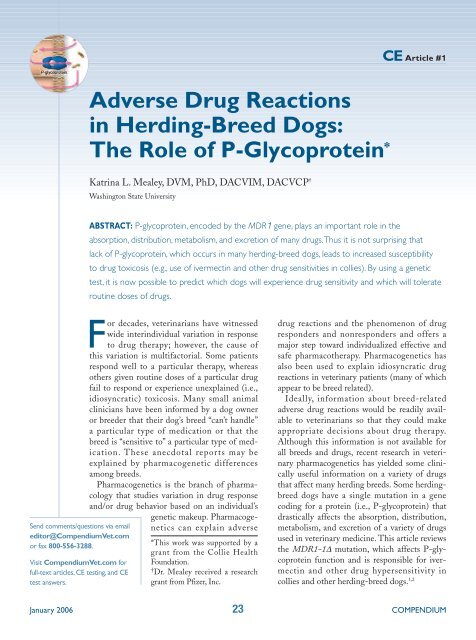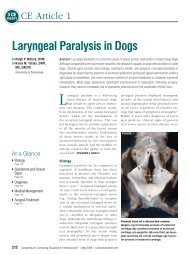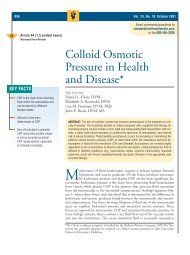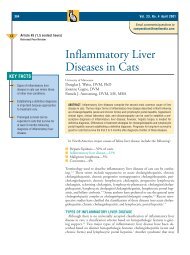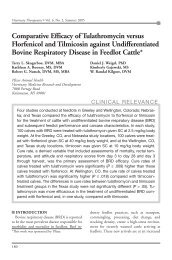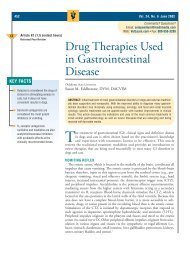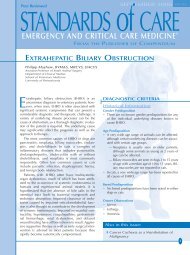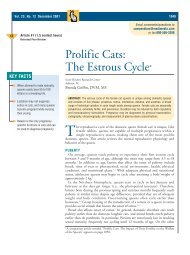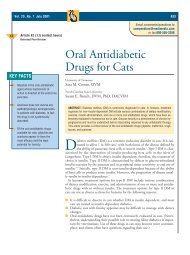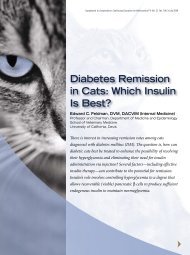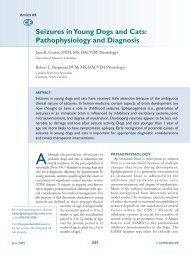The Role of P-Glycoprotein - VetLearn.com
The Role of P-Glycoprotein - VetLearn.com
The Role of P-Glycoprotein - VetLearn.com
- TAGS
- cp.vetlearn.com
You also want an ePaper? Increase the reach of your titles
YUMPU automatically turns print PDFs into web optimized ePapers that Google loves.
Adverse Drug Reactions<br />
in Herding-Breed Dogs:<br />
<strong>The</strong> <strong>Role</strong> <strong>of</strong> P-<strong>Glycoprotein</strong> *<br />
Katrina L. Mealey, DVM, PhD, DACVIM, DACVCP †<br />
Washington State University<br />
ABSTRACT: P-glycoprotein, encoded by the MDR1 gene, plays an important role in the<br />
absorption, distribution, metabolism, and excretion <strong>of</strong> many drugs.Thus it is not surprising that<br />
lack <strong>of</strong> P-glycoprotein, which occurs in many herding-breed dogs, leads to increased susceptibility<br />
to drug toxicosis (e.g., use <strong>of</strong> ivermectin and other drug sensitivities in collies). By using a genetic<br />
test, it is now possible to predict which dogs will experience drug sensitivity and which will tolerate<br />
routine doses <strong>of</strong> drugs.<br />
F<br />
Send <strong>com</strong>ments/questions via email<br />
editor@CompendiumVet.<strong>com</strong><br />
or fax 800-556-3288.<br />
Visit CompendiumVet.<strong>com</strong> for<br />
full-text articles, CE testing, and CE<br />
test answers.<br />
or decades, veterinarians have witnessed<br />
wide interindividual variation in response<br />
to drug therapy; however, the cause <strong>of</strong><br />
this variation is multifactorial. Some patients<br />
respond well to a particular therapy, whereas<br />
others given routine doses <strong>of</strong> a particular drug<br />
fail to respond or experience unexplained (i.e.,<br />
idiosyncratic) toxicosis. Many small animal<br />
clinicians have been informed by a dog owner<br />
or breeder that their dog’s breed “can’t handle”<br />
a particular type <strong>of</strong> medication or that the<br />
breed is “sensitive to” a particular type <strong>of</strong> medication.<br />
<strong>The</strong>se anecdotal reports may be<br />
explained by pharmacogenetic differences<br />
among breeds.<br />
Pharmacogenetics is the branch <strong>of</strong> pharmacology<br />
that studies variation in drug response<br />
and/or drug behavior based on an individual’s<br />
genetic makeup. Pharmacogenetics<br />
can explain adverse<br />
*This work was supported by a<br />
grant from the Collie Health<br />
Foundation.<br />
† Dr. Mealey received a research<br />
grant from Pfizer, Inc.<br />
Article #1<br />
drug reactions and the phenomenon <strong>of</strong> drug<br />
responders and nonresponders and <strong>of</strong>fers a<br />
major step toward individualized effective and<br />
safe pharmacotherapy. Pharmacogenetics has<br />
also been used to explain idiosyncratic drug<br />
reactions in veterinary patients (many <strong>of</strong> which<br />
appear to be breed related).<br />
Ideally, information about breed-related<br />
adverse drug reactions would be readily available<br />
to veterinarians so that they could make<br />
appropriate decisions about drug therapy.<br />
Although this information is not available for<br />
all breeds and drugs, recent research in veterinary<br />
pharmacogenetics has yielded some clinically<br />
useful information on a variety <strong>of</strong> drugs<br />
that affect many herding breeds. Some herdingbreed<br />
dogs have a single mutation in a gene<br />
coding for a protein (i.e., P-glycoprotein) that<br />
drastically affects the absorption, distribution,<br />
metabolism, and excretion <strong>of</strong> a variety <strong>of</strong> drugs<br />
used in veterinary medicine. This article reviews<br />
the MDR1-1∆ mutation, which affects P-glycoprotein<br />
function and is responsible for ivermectin<br />
and other drug hypersensitivity in<br />
collies and other herding-breed dogs. 1,2<br />
January 2006 23 COMPENDIUM<br />
CE
24 CE<br />
Adverse Drug Reactions in Herding-Breed Dogs:<strong>The</strong> <strong>Role</strong> <strong>of</strong> P-<strong>Glycoprotein</strong><br />
Figure 1. Illustration <strong>of</strong> P-glycoprotein’s role in chemotherapeutic drug resistance. Because P-glycoprotein actively pumps<br />
many chemotherapeutics out <strong>of</strong> the cell, it be<strong>com</strong>es resistant to multiple chemotherapeutics.<br />
This cancer cell does not express P-glycoprotein. This cancer cell does express P-glycoprotein on the plasma<br />
membrane.<br />
P-GLYCOPROTEIN<br />
P-glycoprotein is a pump that transports substrate drugs<br />
across cell membranes. P-glycoprotein first attracted<br />
attention in the 1980s when it was discovered that P-glycoprotein<br />
expression by tumor cells contributed to<br />
chemotherapeutic multidrug resistance (Figure 1) in many<br />
types <strong>of</strong> human cancers. 3,4 Hence, the gene encoding Pglycoprotein<br />
was named MDR1 (multidrug resistance<br />
gene; the most recent nomenclature is ABCB1). Subsequent<br />
work in canine lymphoma and osteosar<strong>com</strong>a cell<br />
lines demonstrated that P-glycoprotein also contributes to<br />
chemotherapeutic resistance in canine cancers. 5,6<br />
Researchers are still investigating P-glycoprotein–<br />
mediated chemotherapy resistance in tumor cells, but a<br />
more recent discovery 61 (in the 1990s) revealed an equally,<br />
if not more, important physiologic function mediated by<br />
P-glycoprotein in nonneoplastic mammalian tissue.<br />
P-glycoprotein is a large (i.e., approximately 170 kD)<br />
protein that contains 12 membrane-spanning motifs. Pglycoprotein<br />
has two drug-binding sites and two ATPbinding<br />
sites located along the intracytoplasmic portion <strong>of</strong><br />
the transporter. If a drug is a substrate for P-glycoprotein,<br />
the drug is actively transported from the intracellular to the<br />
extracellular space. Drug transport by P-glycoprotein is an<br />
ATP-dependent, active process that can function against<br />
steep concentration gradients. 4,7 P-glycoprotein is normally<br />
expressed in various mammalian tissues, including the apical<br />
border <strong>of</strong> intestinal epithelial cells, 8 brain capillary<br />
endothelial cells, 9 biliary canalicular cells, 10 renal proximal<br />
tubular epithelial cells, 11 placenta, 12 and testes. 13 P-glycoprotein<br />
actively pumps substrate drugs from within the cell<br />
back into the lumen <strong>of</strong> the intestine, brain capillary, bile<br />
canaliculus, or renal tubule, respectively. Consequently, it is<br />
tempting to speculate that P-glycoprotein functions in a<br />
protective capacity by decreasing exposure <strong>of</strong> the organism<br />
to potentially toxic xenobiotics in the environment.<br />
P-glycoprotein homologues also exist in lower organisms,<br />
including Plasmodium falciparum, Candida albicans,<br />
Saccharomyces cerevisiae, and Lactococcus lactis. 14 In these<br />
lower organisms, P-glycoprotein–like multidrug transport<br />
pumps play an important role in conferring drug resistance<br />
on pathogens. For example, the MDR1 homologue gene in<br />
P. falciparum (i.e., malaria) is associated with chloroquine<br />
resistance. 15 P-glycoprotein homologues in C. albicans and<br />
L. lactis appear to contribute to azole 16 and antibiotic 17<br />
resistance, respectively. P-glycoprotein homologues also<br />
contribute to anthelmintic resistance such as ivermectin<br />
resistance in Haemonchus spp and other nematodes. 18 Thus<br />
it seems likely that the physiologic role <strong>of</strong> P-glycoprotein<br />
in both simple and <strong>com</strong>plex organisms is to minimize an<br />
organism’s exposure to potentially toxic xenobiotics by<br />
pumping them out <strong>of</strong> protected sites and promoting their<br />
excretion in the intestinal, biliary, and urinary tracts.<br />
Mammalian P-glycoprotein has wide substrate specificity,<br />
transporting a number <strong>of</strong> drugs with diverse<br />
chemical structures, including anticancer agents (i.e.,<br />
vinca alkaloids, doxorubicin), immunosuppressants (i.e.,<br />
cyclosporine, tacrolimus), antiparasitic agents (i.e., iver-<br />
COMPENDIUM January 2006<br />
Illustrations by Felecia Paras
Selected P-<strong>Glycoprotein</strong> Substrates 20,22–24,59<br />
Anticancer agents<br />
• Doxorubicin<br />
• Docetaxel a<br />
• Vincristine a<br />
• Vinblastine a<br />
• Etoposide a<br />
• Actinomycin D<br />
Steroid hormones<br />
• Aldosterone<br />
• Cortisol a<br />
• Dexamethasone a<br />
• Methylprednisolone<br />
Antimicrobial agents<br />
• Erythromycin a<br />
• Ketoconazole<br />
• Itraconazole a<br />
• Tetracycline<br />
• Doxycycline<br />
• Lev<strong>of</strong>loxacin<br />
• Sparfloxacin<br />
a Substrate <strong>of</strong> CYP3A.<br />
mectin, selamectin), steroid hormones (e.g., cortisol,<br />
dexamethasone), and others 19,20 (see box on this page).<br />
<strong>The</strong> mechanism by which P-glycoprotein can recognize<br />
and transport such a structurally diverse range <strong>of</strong> <strong>com</strong>pounds<br />
is unknown, and attempts to predict whether a<br />
drug will be a P-glycoprotein substrate based purely on<br />
chemical structure have not been successful. 21 Interestingly,<br />
most P-glycoprotein substrates are natural <strong>com</strong>pounds<br />
or synthetic derivatives <strong>of</strong> natural <strong>com</strong>pounds.<br />
Vinca alkaloids, opioids, and digoxin are plant-derived<br />
drugs, whereas avermectins, doxorubicin, and cyclosporine<br />
are derived from fungal organisms.<br />
A list <strong>of</strong> drugs relevant to veterinary medicine that are<br />
reportedly P-glycoprotein substrates is provided (see box<br />
on this page). More <strong>com</strong>prehensive lists <strong>of</strong> P-glycoprotein<br />
substrates are available elsewhere. 20,22–24 Many drugs have<br />
not been specifically evaluated regarding their status as Pglycoprotein<br />
substrates, so other drugs used in veterinary<br />
medicine will likely be identified as such and added to<br />
these lists. To date, it appears that P-glycoprotein substrate<br />
specificity is relevant across species. For instance, drugs<br />
determined to be substrates for murine P-glycoprotein<br />
are also substrates for both human and canine P-glycoprotein.<br />
1,6,25 However, studies specifically addressing this ques-<br />
Adverse Drug Reactions in Herding-Breed Dogs:<strong>The</strong> <strong>Role</strong> <strong>of</strong> P-<strong>Glycoprotein</strong> CE 25<br />
Opioids<br />
• Loperamide<br />
• Morphine<br />
• Butorphanol<br />
Cardiac drugs<br />
• Digoxin<br />
• Diltiazem a<br />
• Verapamil a<br />
• Talinolol<br />
Immunosuppressants<br />
• Cyclosporine a<br />
• Tacrolimus a<br />
Miscellaneous<br />
• Ivermectin and<br />
other avermectins<br />
• Amitriptyline<br />
• Terfenadine a<br />
• Ondansetron<br />
• Domperidon<br />
• Acepromazine<br />
• Vecuronium<br />
Figure 2. Illustration <strong>of</strong> the interactive role <strong>of</strong> Pglycoprotein<br />
and CYP3A in modulating oral absorption<br />
<strong>of</strong> substrate drugs. Three possible out<strong>com</strong>es exist for<br />
substrate drugs: (1) the drug may be metabolized by CYP3A, (2)<br />
the drug may enter the systemic circulation, or (3) the drug may<br />
be extruded by P-glycoprotein back into the intestinal lumen,<br />
where it may enter another enterocyte at a more distal site along<br />
the digestive tract, thus allowing further access to CYP3A.<strong>The</strong><br />
net result is that non–P-glycoprotein/CYP3A substrate drugs pass<br />
through the enterocyte only once, whereas P-glycoprotein<br />
substrates may be continually cycled between the enterocyte and<br />
the gut lumen, resulting in repeated access <strong>of</strong> CYP3A to the drug<br />
molecule or fecal excretion <strong>of</strong> the drug due to repeated Pglycoprotein<br />
efflux.<br />
tion have not been conducted. One study 26 using tumor<br />
cell lines provides evidence that doxorubicin and vincristine<br />
are substrates for feline P-glycoprotein.<br />
ROLE OF P-GLYCOPROTEIN IN<br />
DRUG DISPOSITION<br />
<strong>The</strong> initial discovery that P-glycoprotein was an<br />
important determinant in drug disposition was<br />
January 2006 COMPENDIUM<br />
Illustration by Felecia Paras
26 CE<br />
Adverse Drug Reactions in Herding-Breed Dogs:<strong>The</strong> <strong>Role</strong> <strong>of</strong> P-<strong>Glycoprotein</strong><br />
serendipitous. A group <strong>of</strong> investigators studying P-glycoprotein<br />
genetically engineered a strain <strong>of</strong> mice that do<br />
not express P-glycoprotein (mdr1a[-/-] knockout<br />
mice). 27 <strong>The</strong>se researchers were initially surprised and<br />
perhaps somewhat disappointed that these mice were<br />
healthy and fertile and appeared to live a normal life<br />
span without P-glycoprotein expression in their tissue.<br />
No anatomic malformations were detected in these<br />
mice, and there were no abnormalities in the results <strong>of</strong><br />
<strong>com</strong>plete blood cell counts, serum biochemistry pr<strong>of</strong>iles,<br />
or other physiologic parameters. 27,28 It was concluded<br />
that under normal laboratory conditions, P-glycoprotein<br />
was not essential for the basic physiologic functioning <strong>of</strong><br />
an organism. Interest in the mdr1a(-/-) knockout mouse<br />
would have waned had it not been for a mite infestation<br />
in this colony. <strong>The</strong> infected mice were treated according<br />
to standard operating procedures for the facility by<br />
spraying a solution <strong>of</strong> ivermectin. Within 24 hours,<br />
nearly all <strong>of</strong> the mdr1a(-/-) mice had died, whereas<br />
none <strong>of</strong> the wild-type (i.e., normal mice that express Pglycoprotein)<br />
mice showed abnormal signs. <strong>The</strong><br />
researchers ultimately determined that the blood–brain<br />
barrier in mdr1a(-/-) mice was defective, resulting in<br />
100-fold greater concentrations <strong>of</strong> ivermectin in brain<br />
tissue <strong>of</strong> the knockout mice <strong>com</strong>pared with wild-type<br />
mice. 27–29 This discovery paved the way for literally hundreds<br />
<strong>of</strong> subsequent studies investigating the role <strong>of</strong> Pglycoprotein<br />
in drug disposition, including studies <strong>of</strong><br />
ivermectin sensitivity in collies.<br />
For years, ivermectin sensitivity has been described in<br />
a subpopulation <strong>of</strong> collies and other herding breeds. 30<br />
<strong>The</strong>se dogs appear to display the same phenotype as do<br />
mdr1a(-/-) knockout mice after exposure to ivermectin.<br />
Not surprisingly, a mutation in the MDR1 gene has<br />
been identified in these dogs. A four base-pair deletion<br />
mutation produces a frame shift in the gene <strong>of</strong> affected<br />
dogs. 1 This frame shift generates a premature stop<br />
codon in MDR1, resulting in a severely truncated, nonfunctional<br />
protein. Dogs homozygous for this mutation<br />
(i.e., MDR1-1∆) experience adverse neurologic effects<br />
after a single dose (i.e., 100 µg/kg) <strong>of</strong> ivermectin.<br />
<strong>Role</strong> <strong>of</strong> P-<strong>Glycoprotein</strong> in Intestinal<br />
Drug Absorption<br />
P-glycoprotein is expressed on the lumenal border <strong>of</strong><br />
intestinal epithelial cells (Figure 2), where it transports<br />
substrate drugs from the cytoplasm back into the intestinal<br />
lumen. In mdr1a(-/-) knockout mice, the oral<br />
bioavailability <strong>of</strong> paclitaxel, a chemotherapeutic agent<br />
known to be a P-glycoprotein substrate, is threefold<br />
greater than in wild-type mice. 31 Similar results have<br />
been documented with other orally administered P-glycoprotein<br />
substrates, including cyclosporin A, 32 βadrenergic<br />
antagonists, 33 opioids, 34,35 ivermectin, 36<br />
digoxin, 28,37 dexamethasone, 28 fluoroquinolones, 38 and<br />
other drugs used in mice. Peak plasma concentrations <strong>of</strong><br />
the P-glycoprotein substrate morphine were also<br />
tw<strong>of</strong>old higher in humans pretreated with a P-glycoprotein<br />
inhibitor (i.e., a drug that inhibits P-glycoprotein<br />
function) than in patients receiving morphine alone.<br />
A mutation in the gene encoding P-glycoprotein occurs in some herding-breed<br />
dogs, rendering them extremely susceptible to toxicosis resulting from<br />
administration <strong>of</strong> ivermectin, loperamide, vincristine, doxorubicin, and other drugs.<br />
<strong>The</strong>se results indicate that P-glycoprotein plays a major<br />
role in limiting intestinal absorption <strong>of</strong> many drugs in<br />
human and rodent studies.<br />
In dogs, there is also evidence that P-glycoprotein<br />
limits oral absorption <strong>of</strong> some drugs. Oral absorption <strong>of</strong><br />
paclitaxel is enhanced in dogs treated with drugs that<br />
block P-glycoprotein function. 39 When paclitaxel was<br />
administered to dogs in conjunction with a P-glycoprotein<br />
inhibitor, peak plasma concentrations were 15-fold<br />
greater than when paclitaxel was administered alone.<br />
Similarly, coadministration <strong>of</strong> cyclosporin with grapefruit<br />
juice, an inhibitor <strong>of</strong> both P-glycoprotein and<br />
cytochrome P450 3A (CYP3A), increased oral absorption<br />
<strong>of</strong> cyclosporin in dogs. 40 Digoxin toxicity was<br />
recently documented in a collie homozygous for the<br />
MDR1-1∆ mutation. 41 This patient developed an<br />
unusually high serum digoxin concentration that led to<br />
digoxin toxicosis despite administration <strong>of</strong> a reduced<br />
(i.e., 60% <strong>of</strong> the calculated daily dose) digoxin dosage<br />
(i.e., 0.002 mg/kg in the morning and 0.004 mg/kg in<br />
the evening; re<strong>com</strong>mended dosage: 0.005 mg/kg bid). 42<br />
Because other factors that precipitate digoxin toxicosis,<br />
such as obesity, hypokalemia, or azotemia, were not<br />
COMPENDIUM January 2006
present, it seems likely that lack <strong>of</strong> P-glycoprotein led to<br />
increased oral bioavailability and decreased intestinal<br />
and/or renal excretion <strong>of</strong> digoxin in this collie.<br />
<strong>Role</strong> <strong>of</strong> P-<strong>Glycoprotein</strong> in Drug Distribution<br />
P-glycoprotein is an important <strong>com</strong>ponent <strong>of</strong> the<br />
blood–brain, blood–placenta, and blood–testes barriers,<br />
minimizing the distribution <strong>of</strong> substrate drugs to these<br />
tissues. Dogs that lack P-glycoprotein (i.e., those<br />
homozygous for the MDR1-1∆ mutation) experience<br />
pr<strong>of</strong>ound neurologic effects when given “normal” doses <strong>of</strong><br />
ivermectin and loperamide (Imodium, McNeil Consumer<br />
Healthcare). For example, 300 µg/kg <strong>of</strong> ivermectin (i.e.,<br />
low end <strong>of</strong> dosing range for demodectic mange) is well<br />
tolerated by most dogs but induces neurologic toxicosis<br />
(i.e., hypersalivation, mydriasis, ataxia, impaired postural<br />
and cranial nerve reflexes, stupor, <strong>com</strong>a) in dogs with the<br />
MDR1-1∆ mutation. <strong>The</strong> re<strong>com</strong>mended dose <strong>of</strong> loperamide<br />
(0.2 mg/kg) also causes neurologic toxicosis,<br />
with clinical signs similar to those <strong>of</strong> ivermectin toxicosis,<br />
in dogs with the MDR1-1∆ mutation but produces no<br />
adverse effects in dogs that express P-glycoprotein normally<br />
(MDR1 wild-type dogs). 43 Loperamide is an opioid<br />
that is generally devoid <strong>of</strong> central nervous system (CNS)<br />
activity because it is excluded from the brain by P-glycoprotein.<br />
35,44 Dogs with the MDR1-1∆ mutation also<br />
appear to have increased susceptibility to neurologic<br />
adverse effects <strong>of</strong> other macrocyclic lactones, including<br />
milbemycin, selamectin, 45 and moxidectin. 46 Similarly, I<br />
have observed apparent sensitivity to acepromazine and<br />
butorphanol in dogs homozygous for the MDR1-1∆<br />
mutation <strong>com</strong>pared with MDR1 wild-type dogs receiving<br />
the same dose. MDR1-1∆–mutant dogs experienced<br />
more pronounced and protracted CNS depression than<br />
did wild-type dogs.<br />
<strong>Role</strong> <strong>of</strong> P-<strong>Glycoprotein</strong> in Drug Metabolism<br />
Although P-glycoprotein itself does not have metabolic<br />
functions, it was recently shown to be an important<br />
<strong>com</strong>ponent <strong>of</strong> intestinal drug metabolism in<br />
humans by working in conjunction with CYP3A.<br />
Because CYP3A is one <strong>of</strong> the most abundant<br />
cytochrome P450 enzymes and is known to be responsi-<br />
Adverse Drug Reactions in Herding-Breed Dogs:<strong>The</strong> <strong>Role</strong> <strong>of</strong> P-<strong>Glycoprotein</strong> CE 27<br />
Selected P-<strong>Glycoprotein</strong> Inhibitors 19,22,25,35,60,61<br />
Antidepressants<br />
• Fluoxetine<br />
• Saint John’s Wort<br />
• Paroxetine<br />
Antimicrobials<br />
• Erythromycin a,b<br />
• Itraconazole a<br />
• Ketoconazole a,b<br />
Opioids<br />
• Methadone<br />
• Pentazocine<br />
a CYP3A substrate.<br />
b CYP3A inhibitor.<br />
Cardiac drugs<br />
• Verapamil a<br />
• Amiodarone a<br />
• Carvedilol<br />
• Quinidine a<br />
• Nicardipine a<br />
Immunosuppressants<br />
• Cyclosporine a<br />
• Tacrolimus a<br />
Miscellaneous<br />
• Bromocriptine<br />
• Chlorpromazine<br />
• Tamoxifen a<br />
• Grapefruit juice b<br />
ble for the metabolism <strong>of</strong> about 60% <strong>of</strong> currently known<br />
human drugs, it is considered the major phase-one<br />
drug-metabolizing enzyme family in mammals. 47,48<br />
CYP3A and P-glycoprotein are expressed at high levels<br />
in the villus tip <strong>of</strong> enterocytes in the gastrointestinal<br />
(GI) tract, the primary absorptive site for orally administered<br />
drugs (Figure 2). Because so many drugs are substrates<br />
for both CYP3A and P-glycoprotein, it appears<br />
that the two proteins work in concert to prevent oral<br />
absorption <strong>of</strong> many drugs (see box on page 25). Once a<br />
drug is absorbed by the intestine, three possible out-<br />
P-glycoprotein plays an important role in the absorption, distribution, metabolism,<br />
and excretion <strong>of</strong> a wide variety <strong>of</strong> drugs used in veterinary medicine.<br />
<strong>com</strong>es exist in the enterocyte: <strong>The</strong> drug may be metabolized<br />
by CYP3A, may enter the systemic blood<br />
circulation, or may be extruded by P-glycoprotein back<br />
into the intestinal lumen, where it may be reabsorbed<br />
distally into another enterocyte. <strong>The</strong> net result is that<br />
non–P-glycoprotein/CYP3A substrate drugs pass<br />
through the enterocyte only once, whereas P-glycoprotein<br />
substrates may continually undergo cycling between<br />
the enterocyte and the gut lumen, resulting in repeated<br />
access <strong>of</strong> CYP3A for drug metabolism, or fecal excretion<br />
<strong>of</strong> the drug due to repeated P-glycoprotein efflux in<br />
the intestinal lumen.<br />
January 2006 COMPENDIUM
28 CE<br />
Adverse Drug Reactions in Herding-Breed Dogs:<strong>The</strong> <strong>Role</strong> <strong>of</strong> P-<strong>Glycoprotein</strong><br />
Breeds in Which the MDR1-1∆ Mutation<br />
Has Been Documented<br />
Herding breeds Sighthounds<br />
• Collie • Longhaired whippet<br />
• Australian shepherd • Silken windhound<br />
(standard and miniature)<br />
• English shepherd<br />
• McNab<br />
• Old English sheepdog<br />
• Shetland sheepdog<br />
• German shepherd a<br />
• Border collie b<br />
a Frequency in white dogs is greater than in dogs <strong>of</strong> other colors.<br />
b Based only on dog’s appearance (these dogs were not registered<br />
in the American Kennel Club).<br />
P-<strong>Glycoprotein</strong> Inhibition<br />
Many veterinarians have, perhaps unknowingly,<br />
affected the P-glycoprotein/CYP3A system when using<br />
ketoconazole to increase the oral bioavailability <strong>of</strong><br />
cyclosporine. 49,50 Although the mechanisms are not<br />
entirely clear, ketoconazole inhibits both CYP3A metabolic<br />
activity and P-glycoprotein efflux activity. While<br />
this particular drug interaction is used for therapeutic<br />
benefit, a number <strong>of</strong> other potentially adverse drug<br />
interactions exist between CYP3A and P-glycoprotein<br />
substrates and inhibitors. A number <strong>of</strong> drugs are known<br />
to inhibit P-glycoprotein and CYP3A in humans (see<br />
box on page 27). Concurrent use <strong>of</strong> drugs listed in the<br />
box on page 25 with drugs listed in the box on page 27<br />
should be avoided, or plasma drug concentrations<br />
should be measured to avoid drug toxicosis.<br />
<strong>Role</strong> <strong>of</strong> P-<strong>Glycoprotein</strong> in Biliary and Renal<br />
Drug Excretion<br />
Renal and biliary excretion are the most important<br />
pathways <strong>of</strong> drug elimination, but excretion may also<br />
occur by other routes, such as the intestine (as already<br />
described). As noted previously, P-glycoprotein is<br />
expressed on renal tubular and biliary canalicular cell<br />
membranes. Concurrent administration <strong>of</strong> a P-glycoprotein<br />
inhibitor decreases the biliary and renal clearance<br />
<strong>of</strong> doxorubicin in rats. 51 Figure 3 demonstrates<br />
accumulation <strong>of</strong> the radiolabeled P-glycoprotein substrate<br />
(i.e., 99mTc-sestamibi) in the gallbladder <strong>of</strong> an<br />
MDR1 wild-type dog but a distinct lack <strong>of</strong> radioactivity<br />
in the gallbladder area in a dog with the MDR1-1∆<br />
mutation, providing visual evidence that P-glycoprotein<br />
Gallbladder<br />
MDR1 wild-type MDR1 mut/mut<br />
Figure 3. Nuclear scintigraphic image <strong>of</strong> an MDR1 wildtype<br />
(left) and MDR1 (mut/mut; right) dog 60 minutes<br />
after intravenous injection <strong>of</strong> a radiolabeled Pglycoprotein<br />
substrate (99mTc-sestamibi). <strong>The</strong> gallbladder<br />
can be easily observed in one dog (left) because sestamibi is<br />
pumped into the bile by P-glycoprotein.<strong>The</strong> gallbladder is not<br />
visible in another dog (right) because it lacks P-glycoprotein.<br />
plays an important role in biliary excretion <strong>of</strong> P-glycoprotein<br />
substrates in dogs (unpublished research by the<br />
author). Altered biliary and/or renal excretion may play<br />
a role in the apparent increased sensitivity <strong>of</strong> herding<br />
breeds to chemotherapeutic drugs that are P-glycoprotein<br />
substrates. For example, dogs with the MDR1-1∆<br />
mutation are extremely susceptible to myelosuppression<br />
and GI toxicosis induced by the chemotherapeutic<br />
agents vincristine and doxorubicin (which are P-glycoprotein<br />
substrates), even at low doses, but appear to tolerate<br />
cyclophosphamide (which is not a P-glycoprotein<br />
substrate) at the full dose. 52 It is likely that deficient Pglycoprotein<br />
in these animals results in delayed renal<br />
and/or biliary excretion and subsequent toxicosis.<br />
ASSESSMENT OF MDR1 GENOTYPE IN<br />
CLINICAL PATIENTS<br />
To date, the MDR1-1∆ mutation has been identified<br />
in 10 different dog breeds (see box on this page). In a<br />
study 53 involving collies from the northwestern United<br />
States, over 75% had at least one mutant allele (i.e., 35%<br />
were homozygous for the mutant allele, and 42% were<br />
heterozygous). A similar distribution was described in<br />
separate studies involving over 250 collies, primarily<br />
from the United States, 54 and in collies from France 55<br />
COMPENDIUM January 2006
and Australia, 56 indicating that most collies have at least<br />
one mutant allele. Surprisingly, the longhaired whippet<br />
also has a high frequency <strong>of</strong> the MDR1-1∆ mutation,<br />
with roughly 65% having at least one mutant allele (i.e.,<br />
16% were homozygous for the mutant allele, and 52%<br />
were heterozygous). 54 Based on discussions with some<br />
owners, I believe that the mutation may have been<br />
introduced into the breed by a Shetland sheepdog or<br />
other herding-breed dog in an effort to enhance the<br />
desired longhaired trait. <strong>The</strong> frequency <strong>of</strong> the MDR1-<br />
1∆ mutation is lower in other affected breeds.<br />
It has been proposed that the mutation originated in a<br />
working sheepdog, likely one that lived in the United<br />
Kingdom in the 1800s, predating the emergence <strong>of</strong> formal<br />
breeds. 54 <strong>The</strong> first formal breeds to emerge from<br />
working sheepdog populations were the collie, Old<br />
English sheepdog, and Shetland sheepdog. Other<br />
breeds affected by the MDR1-1∆ mutation are thought<br />
to have been derived from these breeds.<br />
Clinical Implications<br />
<strong>The</strong> presence <strong>of</strong> the MDR1-1∆ mutation in a particular<br />
patient has broad clinical implications with respect to<br />
veterinary medicine. For example, use <strong>of</strong> vincristine or<br />
doxorubicin in a collie or related breed with the MDR1-<br />
1∆ mutation causes severe GI toxicosis and myelosuppression,<br />
even after 25% dose reductions. 57 Use <strong>of</strong><br />
loperamide (Imodium) for treating diarrhea or ivermectin<br />
for treating mange (200 to 400 µg/kg) in a dog homozygous<br />
for the MDR1-1∆ mutation causes severe neurotoxicity.<br />
Apparently, dogs heterozygous for the MDR1-1∆<br />
mutation are susceptible to vincristine and doxorubicin<br />
sensitivity (i.e., phenotypically sensitive) but have an<br />
intermediate phenotype with respect to ivermectin sensitivity.<br />
Some heterozygous dogs have been successfully<br />
treated with ivermectin (300 µg/kg) for demodectic and<br />
sarcoptic mange. However, it is important to note that<br />
dogs were very closely monitored for neurologic toxicity,<br />
and discontinuation <strong>of</strong> ivermectin for 2 to 3 weeks was<br />
necessary in some instances. In each <strong>of</strong> these instances,<br />
the MDR1-1∆ genotype <strong>of</strong> the patient was known before<br />
Adverse Drug Reactions in Herding-Breed Dogs:<strong>The</strong> <strong>Role</strong> <strong>of</strong> P-<strong>Glycoprotein</strong> CE 29<br />
Information on Testing for the MDR1-1∆<br />
Genotype in Clinical Patients<br />
Veterinary Clinical Pharmacology Laboratory<br />
(VCPL)<br />
College <strong>of</strong> Veterinary Medicine<br />
Washington State University<br />
Web: www.vetmed.wsu.edu/vcpl<br />
Phone: 509-335-3745<br />
Price<br />
$60 for one dog<br />
$51 per sample for five or more dogs submitted as one<br />
batch<br />
Sample required<br />
Cheek swab sample to collect DNA<br />
Processing requirements<br />
Cheek swab testing kits are obtained by contacting<br />
VCPL. Instructions for obtaining an appropriate sample<br />
are on the Web site (above) and are included with the<br />
test kit. Samples do not require refrigeration and can be<br />
returned via regular mail.<br />
Turnaround time<br />
For samples received by Tuesday afternoon, results are<br />
available by Friday afternoon (Pacific time).<br />
ivermectin was administered, so the owner and veterinarian<br />
were highly aware <strong>of</strong> the risk <strong>of</strong> toxicity.<br />
A <strong>com</strong>mercially available test is now available so that<br />
all veterinarians can screen dogs for the MDR1 genotype<br />
before administering drugs that are substrates for P-glycoprotein<br />
(see box on this page). Rather than heeding<br />
A genetic test is now available to screen herding-breed dogs for the<br />
mutation, allowing veterinarians to determine whether P-glycoprotein drugs<br />
can be safely administered to a particular patient or should be avoided.<br />
the adage “white feet, don’t treat” regarding ivermectin<br />
use, clinicians can use a DNA-based test in most herding-breed<br />
dogs to determine whether they will benefit<br />
from treatment with ivermectin for demodectic or sarcoptic<br />
mange. Similarly, dogs can be genotyped before<br />
treatment with other P-glycoprotein substrate drugs. For<br />
example, MDR1 genotyping is being used by veterinary<br />
oncologists to determine whether lower chemotherapeutic<br />
drug doses (or alternative drugs) should be adminis-<br />
January 2006 COMPENDIUM
30 CE<br />
Adverse Drug Reactions in Herding-Breed Dogs:<strong>The</strong> <strong>Role</strong> <strong>of</strong> P-<strong>Glycoprotein</strong><br />
Table 1. Summary <strong>of</strong> Reported Adverse Drug Reactions in Patient(s) with the<br />
MDR1-1∆ Mutation<br />
Nature <strong>of</strong> Adverse Supportive Evidence/<br />
Drug(s) Toxic Dose Drug Reaction Data Source<br />
Antiparasitics<br />
Ivermectin >100 µg/kg (20× label dose CNS toxicosis 1,2,62 Prospective studies<br />
for heartworm prevention) Case reports<br />
Author’s unpublished data<br />
Package insert<br />
Personal <strong>com</strong>munications<br />
Selamectin 10× label dose Mild CNS toxicosis Manufacturer<br />
at 10× label dose<br />
Moxidectin 30× label dose CNS toxicosis Manufacturer<br />
Milbemycin 10–20× label dose CNS toxicosis Manufacturer<br />
Abamectin Unknown CNS toxicosis Author’s unpublished data<br />
(pesticide)<br />
Antineoplastics<br />
Doxorubicin 22.5 mg/M 2 causes toxicosis Myelosuppression Case report<br />
in dogs heterozygous for the Severe diarrhea Author’s unpublished data<br />
MDR1-1∆ mutation Anorexia Personal <strong>com</strong>munications<br />
Vincristine (similar 0.56 mg/M 2 causes toxicosis Myelosuppression Case report<br />
effects would be in dogs heterozygous for the Vomiting Author’s unpublished data<br />
expected for MDR1-1∆ mutation Anorexia Personal <strong>com</strong>munications<br />
vinblastine)<br />
Paclitaxel Unknown Myelosuppression None available<br />
and GI effects likely<br />
because paclitaxel is a<br />
P-glycoprotein substrate<br />
Opioids<br />
Loperamide 0.2 mg/kg causes toxicosis Severe CNS depression Case report<br />
in dogs homozygous for the Author’s unpublished data<br />
MDR1-1∆ mutation Personal <strong>com</strong>munications<br />
Effects in heterozygous<br />
animals are unknown<br />
Butorphanol 0.05 mg/kg IV caused greater CNS depression Author’s unpublished data<br />
and more prolonged CNS Re<strong>com</strong>mend 50% <strong>of</strong><br />
depression in MDR1-mutant normal dose in dogs<br />
dogs than in MDR1 wild-type homozygous for the<br />
dogs MDR1-1∆ mutation<br />
Morphine Unknown Likely CNS depression None available<br />
because morphine<br />
is reportedly a<br />
P-glycoprotein substrate<br />
COMPENDIUM January 2006
tered to canine cancer patients carrying a mutant MDR1<br />
allele. 52 Alternatively, if all herding breeds were treated<br />
with lower doses <strong>of</strong> doxorubicin, vincristine, or other Pglycoprotein<br />
substrate chemotherapeutic drugs, these<br />
animals would be at risk <strong>of</strong> shorter remission durations,<br />
which tend to be proportional to drug dose. 58 MDR1<br />
genotyping represents the first step toward incorporating<br />
pharmacogenetics into clinical veterinary medicine.<br />
CONCLUSION<br />
Lack <strong>of</strong> functional P-glycoprotein, as occurs in dogs<br />
with the MDR1-1∆ mutation, alters the absorption, distribution,<br />
metabolism, and excretion <strong>of</strong> a variety <strong>of</strong> <strong>com</strong>monly<br />
used drugs in veterinary medicine, increasing the<br />
risk <strong>of</strong> adverse drug reactions in these patients. Patients<br />
with the MDR1-1∆ mutation may have increased oral<br />
bioavailability <strong>of</strong> substrate drugs because P-glycoprotein is<br />
not present in the GI tract to pump drug back into the<br />
intestinal lumen. Lack <strong>of</strong> P-glycoprotein at the<br />
blood–brain barrier results in increased brain concentrations<br />
<strong>of</strong> P-glycoprotein substrate drugs, greatly enhancing<br />
the risk <strong>of</strong> neurotoxicity. P-glycoprotein expressed on<br />
Adverse Drug Reactions in Herding-Breed Dogs:<strong>The</strong> <strong>Role</strong> <strong>of</strong> P-<strong>Glycoprotein</strong> CE 31<br />
Table 1. Summary <strong>of</strong> Reported Adverse Drug Reactions in Patient(s) with the<br />
MDR1-1∆ Mutation (continued)<br />
Nature <strong>of</strong> Adverse Supportive Evidence/<br />
Drug(s) Toxic Dose Drug Reaction Data Source<br />
Miscellaneous<br />
Acepromazine 0.04 mg/kg caused greater and CNS depression Author’s unpublished data<br />
more prolonged CNS depression Re<strong>com</strong>mend 50% <strong>of</strong><br />
in MDR1-mutant dogs than in normal dose in dogs<br />
MDR1 wild-type dogs homozygous for the<br />
MDR1-1∆ mutation<br />
Dexamethasone Unknown MDR1 mutant dogs Manuscript submitted<br />
experience greater HPA (prospective study)<br />
axis suppression than do<br />
MDR1 wild-type dogs<br />
Digoxin 60% <strong>of</strong> the calculated daily Anorexia Case report (submitted)<br />
digoxin dose resulted in a Vomiting<br />
serum concentration <strong>of</strong> digoxin Cardiotoxicity<br />
four times greater than the<br />
re<strong>com</strong>mended therapeutic range<br />
Ondansetron 0.4 mg/kg caused toxicosis in a CNS toxicosis, including —<br />
collie homozygous for the depression and altered<br />
MDR1-1∆ mutation mentation<br />
HPA = hypothalamic–pituitary–adrenal axis.<br />
enterocytes pumps substrate drugs into the intestinal<br />
lumen; on biliary canalicular cells, it pumps substrates into<br />
bile; and on renal tubular epithelial cells, it pumps substrates<br />
into urine. Dogs homozygous for the MDR1-1∆<br />
mutation lack the capacity for P-glycoprotein–mediated<br />
drug excretion, enhancing the risk <strong>of</strong> adverse drug reactions.<br />
Table 1 contains a summary <strong>of</strong> reported adverse<br />
drug reactions in patient(s) with the MDR1-1∆ mutation.<br />
REFERENCES<br />
1. Mealey KL, Bentjen SA, Gay JM, Cantor GH: Ivermectin sensitivity in collies<br />
is associated with a deletion mutation <strong>of</strong> the mdr1 gene. Pharmacogenetics<br />
11:727–733, 2001.<br />
2. Nelson OL, Carsten E, Bentjen SA, Mealey KL: Ivermectin toxicity in an<br />
Australian shepherd dog with the MDR1 mutation associated with ivermectin<br />
sensitivity in collies. J Vet Intern Med 17:354–356, 2003.<br />
3. Ueda K, Cardarelli C, Gottesman MM, Pastan I: Expression <strong>of</strong> a full-length<br />
cDNA for the human MDR1 gene confers resistance to colchicine, doxorubicin,<br />
and vinblastine. Proc Natl Acad Sci USA:3004–3008, 1987.<br />
4. Juranka PF, Zastawny RL, Ling V: P-glycoprotein: Multidrug-resistance and<br />
a superfamily <strong>of</strong> membrane-associated transport proteins. FASEB J<br />
3:2583–2592, 1989.<br />
5. Bergman PJ, Ogilvie GK, Powers BE: Monoclonal antibody C219 immunohistochemistry<br />
against P-glycoprotein: Sequential analysis and predictive<br />
ability in dogs with lymphoma. J Vet Intern Med 10:354–359, 1996.<br />
6. Mealey KL, Barhoumi R, Rogers K, Kochevar DT: Doxorubicin induced<br />
January 2006 COMPENDIUM
32 CE<br />
Adverse Drug Reactions in Herding-Breed Dogs:<strong>The</strong> <strong>Role</strong> <strong>of</strong> P-<strong>Glycoprotein</strong><br />
expression <strong>of</strong> P-glycoprotein in a canine osteosar<strong>com</strong>a cell line. Cancer Lett<br />
126, 187–192, 1998.<br />
7. Cornwell MM: Molecular biology <strong>of</strong> P-glycoprotein. Cancer Treat Res<br />
57:37–56, 1991.<br />
8. Li M, Hurren R, Zastawny RL, et al: Regulation and expression <strong>of</strong> multidrug<br />
resistance (MDR) transcripts in the intestinal epithelium. Br J Cancer<br />
80:1123–1131, 1999.<br />
9. Cordon-Cardo C, O’Brien JP, Casals D, et al: Multidrug-resistance gene (Pglycoprotein)<br />
is expressed by endothelial cells at blood–brain barrier sites.<br />
Proc Natl Acad Sci USA:695–698, 1989.<br />
10. Thiebaut F, Tsuruo T, Hamada H, et al: Cellular localization <strong>of</strong> the multidrug-resistance<br />
gene product P-glycoprotein in normal human tissues. Proc<br />
Natl Acad Sci USA:7735–7738, 1987.<br />
11. Hori R, Okamura N, Aiba T, Tanigawara Y: <strong>Role</strong> <strong>of</strong> P-glycoprotein in renal<br />
tubular secretion <strong>of</strong> digoxin in the isolated perfused rat kidney. J Pharmacol<br />
Exp <strong>The</strong>r 266:1620–1625, 1993.<br />
12. Lankas GR, Wise LD, Cartwright ME, et al: Placental P-glycoprotein deficiency<br />
enhances susceptibility to chemically induced birth defects in mice.<br />
Reprod Toxicol 12:457–463, 1998.<br />
13. Melaine N, Lienard MO, Dorval I, et al: Multidrug resistance genes and Pglycoprotein<br />
in the testis <strong>of</strong> the rat, mouse, guinea pig, and human. Biol<br />
Reprod 67:1699–1707, 2002.<br />
14. van Veen HW, Konings WN: <strong>The</strong> ABC family <strong>of</strong> multidrug transporters in<br />
microorganisms. Biochim Biophys Acta 1365:31–36, 1998.<br />
15. Volkman SK, Cowman AF, Wirth DF: Functional <strong>com</strong>plementation <strong>of</strong> the<br />
ste6 gene <strong>of</strong> Saccharomyces cerevisiae with the pfmdr1 gene <strong>of</strong> Plasmodium falciparum.<br />
Proc Natl Acad Sci USA:8921–8925, 1995.<br />
16. Ramage G, Bachmann S, Patterson TF, et al: Investigation <strong>of</strong> multidrug<br />
efflux pumps in relation to fluconazole resistance in Candida albicans<br />
bi<strong>of</strong>ilms. J Antimicrob Chemother 49:973–980, 2002.<br />
17. Konings WN, Poelarends GJ: Bacterial multidrug resistance mediated by a<br />
homologue <strong>of</strong> the human multidrug transporter P-glycoprotein. IUBMB Life<br />
53:213–218, 2002.<br />
18. Xu M, Molento M, Blackhall W, et al: Ivermectin resistance in nematodes<br />
may be caused by alteration <strong>of</strong> P-glycoprotein homolog. Mol Biochem Parasitol<br />
91:327–335, 1998.<br />
19. Ford JM, Hait WN: Pharmacologic circumvention <strong>of</strong> multidrug resistance.<br />
Cytotechnology 12:171–212, 1993.<br />
20. Sakaeda T, Nakamura T, Okumura K: MDR1 genotype-related pharmacokinetics<br />
and pharmacodynamics. Biol Pharm Bull 25:1391–1400, 2002.<br />
21. Seelig A: A general pattern for substrate recognition by P-glycoprotein. Eur J<br />
Biochem 251:252–261, 1998.<br />
22. Marzolini C, Paus E, Buclin T, Kim RB: Polymorphisms in human MDR1<br />
(P-glycoprotein): Recent advances and clinical relevance. Clin Pharmacol <strong>The</strong>r<br />
75:13–33, 2004.<br />
23. Schwab M, Eichelbaum M, Fromm MF: Genetic polymorphisms <strong>of</strong> the human<br />
MDR1 drug transporter. Annu Rev Pharmacol Toxicol 43:285–307, 2003.<br />
24. Sakaeda T, Nakamura T, Okumura K: Pharmacogenetics <strong>of</strong> MDR1 and its<br />
impact on the pharmacokinetics and pharmacodynamics <strong>of</strong> drugs. Pharmacogenomics<br />
4:397–410, 2003.<br />
25. Page RL, Hughes CS, Huyan S, et al: Modulation <strong>of</strong> P-glycoprotein–mediated<br />
doxorubicin resistance in canine cell lines. Anticancer Res 20:3533–3538, 2000.<br />
26. Okai Y, Nakamura N, Matsushiro H, et al: Molecular analysis <strong>of</strong> multidrug<br />
resistance in feline lymphoma cells. Am J Vet Res 61:1122–1127, 2000.<br />
27. Schinkel AH, Smit JJ, van Tellingen O, et al: Disruption <strong>of</strong> the mouse mdr1a<br />
P-glycoprotein gene leads to a deficiency in the blood–brain barrier and to<br />
increased sensitivity to drugs. Cell 20(77):491–502, 1994.<br />
28. Schinkel AH, Wagenaar E, van Deemter L, et al: Absence <strong>of</strong> the mdr1a Pglycoprotein<br />
in mice affects tissue distribution and pharmacokinetics <strong>of</strong> dexamethasone,<br />
digoxin, and cyclosporin A. J Clin Invest 96:1698–1705, 1995.<br />
29. Schinkel AH, Mol CA, Wagenaar E, et al: Multidrug resistance and the role<br />
<strong>of</strong> P-glycoprotein knockout mice. Eur J Cancer 31A:1295–1298, 1995.<br />
30. Paul AJ, Tranquilli WJ, Seward RL, et al: Clinical observations in collies<br />
given ivermectin orally. Am J Vet Res 48:684–685, 1987.<br />
31. Sparreboom A, van Asperen J, Mayer U, et al: Limited oral bioavailability<br />
and active epithelial excretion <strong>of</strong> paclitaxel (Taxol) caused by P-glycoprotein<br />
in the intestine. Proc Natl Acad Sci USA:2031–2035, 1997.<br />
32. Lown KS, Mayo RR, Leichtman AB, et al: <strong>Role</strong> <strong>of</strong> intestinal P-glycoprotein<br />
(mdr1) in interpatient variation in the oral bioavailability <strong>of</strong> cyclosporine.<br />
Clin Pharmacol <strong>The</strong>r 62:248–260, 1997.<br />
33. Schwarz UI, Gramatte T, Krappweis J, et al: Unexpected effect <strong>of</strong> verapamil<br />
on oral bioavailability <strong>of</strong> the beta-blocker talinolol in humans. Clin Pharmacol<br />
<strong>The</strong>r 65:283–290, 1999.<br />
34. Bouer R, Barthe L, Philibert C, et al: <strong>The</strong> roles <strong>of</strong> P-glycoprotein and intracellular<br />
metabolism in the intestinal absorption <strong>of</strong> methadone: In vitro studies<br />
using the rat everted intestinal sac. Fundam Clin Pharmacol 13:494–500,<br />
1999.<br />
35. Wandel C, Kim R, Wood M, Wood A: Interaction <strong>of</strong> morphine, fentanyl,<br />
sufentanil, alfentanil, and loperamide with the efflux drug transporter P-glycoprotein.<br />
Anesthesiology 96:913–920, 2002.<br />
36. Kwei GY, Alvaro RF, Chen Q, et al: Disposition <strong>of</strong> ivermectin and<br />
cyclosporin A in CF-1 mice deficient in mdr1a P-glycoprotein. Drug Metab<br />
Dispos 27:581–587, 1999.<br />
37. Westphal K, Weinbrenner A, Giessmann T, et al: Oral bioavailability <strong>of</strong><br />
digoxin is enhanced by talinolol: Evidence for involvement <strong>of</strong> intestinal Pglycoprotein.<br />
Clin Pharmacol <strong>The</strong>r 68:6–12, 2000.<br />
38. Yamaguchi H, Yano I, Saito H, Inui K: Pharmacokinetic role <strong>of</strong> P-glycoprotein<br />
in oral bioavailability and intestinal secretion <strong>of</strong> grepafloxacin in vivo. J<br />
Pharmacol Exp <strong>The</strong>r 300:1063–1069, 2002.<br />
39. McEntee M, Silverman JA, Rassnick K, et al: Enhanced bioavailability <strong>of</strong><br />
oral docetaxel by coadministration <strong>of</strong> cyclosporin A in dogs and rats. Vet<br />
Comp Oncol 2:105–112, 2003.<br />
40. Amatori FM, Meucci V, Giusiani M, et al: Effect <strong>of</strong> grapefruit juice on the<br />
pharmacokinetics <strong>of</strong> cyclosporine in dogs. Vet Rec 154:180–181, 2004.<br />
41. Henick RA, Kellum HB, Bentjen SA, Mealey KL: Digoxin and mexiletine<br />
sensitivity in a collie with the mdr1 mutation. J Vet Intern Med, accepted for<br />
publication, 2005.<br />
42. Boothe D: Small Animal Clinical Pharmacology and <strong>The</strong>rapeutics. Philadelphia,<br />
WB Saunders, 2001.<br />
43. Sartor LL, Bentjen SA, Trepanier L, Mealey KL: Loperamide toxicity in a<br />
collie with the MDR1 mutation associated with ivermectin sensitivity. J Vet<br />
Intern Med 18:117–118, 2004.<br />
44. Ericsson CD, Johnson PC: Safety and efficacy <strong>of</strong> loperamide. Am J Med<br />
88:10S–14S, 1990.<br />
45. Package insert: Revolution, Pfizer, 2005.<br />
46. Tranquilli WJ, Paul AJ, Todd KS: Assessment <strong>of</strong> toxicosis induced by highdose<br />
administration <strong>of</strong> milbemycin oxime in collies. Am J Vet Res<br />
52:1170–1172, 1991.<br />
47. Patel J, Mitra AK: Strategies to over<strong>com</strong>e simultaneous P-glycoprotein mediated<br />
efflux and CYP3A4 mediated metabolism <strong>of</strong> drugs. Pharmacogenomics<br />
2:401–415, 2001.<br />
48. Zhang Y, Benet LZ: <strong>The</strong> gut as a barrier to drug absorption: Combined role <strong>of</strong><br />
cytochrome P450 3A and P-glycoprotein. Clin Pharmacokinet 40:159–168, 2001.<br />
49. Dahlinger J, Gregory C, Bea J: Effect <strong>of</strong> ketoconazole on cyclosporine dose<br />
in healthy dogs. Vet Surg 27:64–68, 1998.<br />
50. Patricelli AJ, Hardie RJ, McAnulty JE: Cyclosporine and ketoconazole for<br />
the treatment <strong>of</strong> perianal fistulas in dogs. JAVMA 220:1009–1016, 2002.<br />
51. Kiso S, Cai SH, Kitaichi K, et al: Inhibitory effect <strong>of</strong> erythromycin on P-glycoprotein–mediated<br />
biliary excretion <strong>of</strong> doxorubicin in rats. Anticancer Res<br />
20:2827–2834, 2000.<br />
52. Mealey KL, Bentjen SA: Unpublished data, Veterinary Clinical Pharmacology<br />
Laboratory, Pullman, WA, 2005.<br />
53. Mealey KL, Bentjen SA, Waiting DK: Frequency <strong>of</strong> the mutant MDR1 allele<br />
associated with ivermectin sensitivity in a sample population <strong>of</strong> collies from<br />
the northwestern United States. Am J Vet Res 63:479–481, 2002.<br />
54. Neff MW, Robertson KR, Wong AK, et al: Breed distribution and history <strong>of</strong><br />
canine MDR1-1(Delta), a pharmacogenetic mutation that marks the emergence<br />
<strong>of</strong> breeds from the collie lineage. Proc Natl Acad Sci USA, 2004.<br />
55. Hugnet C, Bentjen SA, Mealey KL: Frequency <strong>of</strong> the mutant MDR1 allele<br />
associated with multidrug sensitivity in a sample <strong>of</strong> collies from France. J Vet<br />
Pharmacol <strong>The</strong>r 27:227–229, 2004.<br />
56. Mealey KL, Munyard KA, Bentjen SA: Frequency <strong>of</strong> the mutant MDR1<br />
allele associated with multidrug sensitivity in a sample <strong>of</strong> herding breed dogs<br />
living in Australia. Vet Parasitol 131:193–196, 2005.<br />
COMPENDIUM January 2006
57. Mealey KL, Northrup NC, Bentjen SA: Increased toxicity <strong>of</strong> P-glycoproteinsubstrate<br />
chemotherapeutic agents in a dog with the MDR1 deletion mutation<br />
associated with ivermectin sensitivity. JAVMA 223:1434, 1453–1455, 2003.<br />
58. Frei E: Curative cancer chemotherapy. Cancer Res 45:6523-6537, 1985.<br />
59. Fromm MF: Genetically determined differences in P-glycoprotein function:<br />
Implications for disease risk. Toxicology 181–182, 299–303, 2002.<br />
60. Choo EF, Leake B, Wandel C, et al: Pharmacological inhibition <strong>of</strong> P-glyco-<br />
Adverse Drug Reactions in Herding-Breed Dogs:<strong>The</strong> <strong>Role</strong> <strong>of</strong> P-<strong>Glycoprotein</strong> CE 33<br />
protein transport enhances the distribution <strong>of</strong> HIV-1 protease inhibitors into<br />
brain and testes. Drug Metab Dispos 28:655–660, 2000.<br />
61. Sadeque AJ, Wandel C, He H, et al: Increased drug delivery to the brain by<br />
P-glycoprotein inhibition. Clin Pharmacol <strong>The</strong>r 68:231–237, 2000.<br />
62. Roulet A, Puel O, Gesta S, et al: MDR1-deficient genotype in collie dogs<br />
hypersensitive to the P-glycoprotein substrate ivermectin. Eur J Pharmacol<br />
460:85–91, 2003.<br />
ARTICLE #1 CE TEST<br />
This article qualifies for 2 contact hours <strong>of</strong> continuing education credit from the Auburn University College <strong>of</strong> Veterinary<br />
Medicine. Subscribers may purchase individual CE tests or sign up for our annual CE program. Those who wish to apply<br />
this credit to fulfill state relicensure requirements should consult their respective state authorities regarding the applicability<br />
<strong>of</strong> this program. To participate, fill out the test form inserted at the end <strong>of</strong> this issue or take CE tests online and get real-time<br />
scores at CompendiumVet.<strong>com</strong>.<br />
1. P-glycoprotein is not expressed in<br />
a. the stratum corneum.<br />
b. the epithelial lining <strong>of</strong> the GI tract.<br />
c. brain capillary endothelial cells.<br />
d. biliary canalicular cells.<br />
2. Which is not a substrate for P-glycoprotein?<br />
a. vinca alkaloids<br />
b. loperamide<br />
c. digoxin<br />
d. alkylating agents (i.e., cyclophosphamide)<br />
3. Animals deficient in P-glycoprotein function are<br />
susceptible to ivermectin-induced neurotoxicity<br />
because P-glycoprotein<br />
a. metabolizes ivermectin to inactive <strong>com</strong>pounds.<br />
b. is an efflux pump that pumps ivermectin out <strong>of</strong> the<br />
brain.<br />
c. binds ivermectin covalently and prevents it from<br />
being absorbed from the GI tract.<br />
d. is a neurotransmitter that antagonizes the action <strong>of</strong><br />
ivermectin in the brain.<br />
4. <strong>The</strong> MDR1-1∆ mutation has been identified in<br />
a. collies. c. Old English sheepdogs.<br />
b. Shetland sheepdogs. d. all <strong>of</strong> the above<br />
5. In which pharmacokinetic parameter may<br />
P-glycoprotein play a role?<br />
a. absorption c. metabolism<br />
b. distribution d. all <strong>of</strong> the above<br />
6. If contemplating treatment <strong>of</strong> a collie with<br />
demodectic mange, a veterinarian should<br />
a. follow the adage “white feet, don’t treat” and <strong>of</strong>fer<br />
amitraz dips only.<br />
b. <strong>of</strong>fer MDR1 genotyping to determine whether the<br />
dog has the MDR1-1∆ genotype and then decide<br />
whether ivermectin can be safely used in the dog.<br />
CE<br />
c. treat the dog with at least 300 µg/kg q24h <strong>of</strong> ivermectin<br />
until three negative skin scrapings are obtained.<br />
d. apply ivermectin topically to affected areas.<br />
7. Which statement regarding pharmacogenetics is<br />
true?<br />
a. Breed-related adverse drug reactions in dogs are a<br />
figment <strong>of</strong> breeders’ imaginations.<br />
b. Pharmacogenetics can explain all adverse drug reactions<br />
in veterinary and human patients.<br />
c. Pharmacogenetics explains some adverse drug reactions<br />
in veterinary and human patients.<br />
d. Genetic testing for susceptibility to adverse drug<br />
reactions in dogs is not currently feasible for any<br />
drugs used in veterinary medicine.<br />
8. <strong>The</strong> frequency <strong>of</strong> the MDR1-1∆ mutation in collies<br />
is high, with over 75% <strong>of</strong> collies tested having<br />
at least ______ mutant allele(s).<br />
a. one c. three<br />
b. two d. four<br />
9. P-glycoprotein<br />
a. is present in hepatic cells and has intrinsic metabolic<br />
capacity.<br />
b. is present on biliary canalicular cells and transports<br />
substrates into the bile.<br />
c. in the liver works in conjunction with CYP2A to<br />
metabolize and excrete a variety <strong>of</strong> drugs.<br />
d. is not present in the hepatobiliary system.<br />
10. P-glycoprotein<br />
a. function can be inhibited by several drugs, including<br />
ketoconazole.<br />
b. is present on the glomerulus and transports substrates<br />
into the urine.<br />
c. in the kidneys works in conjunction with CYP3A to<br />
metabolize and excrete a variety <strong>of</strong> drugs.<br />
d. is not present in the kidneys.<br />
January 2006 Test answers now available at CompendiumVet.<strong>com</strong> COMPENDIUM


